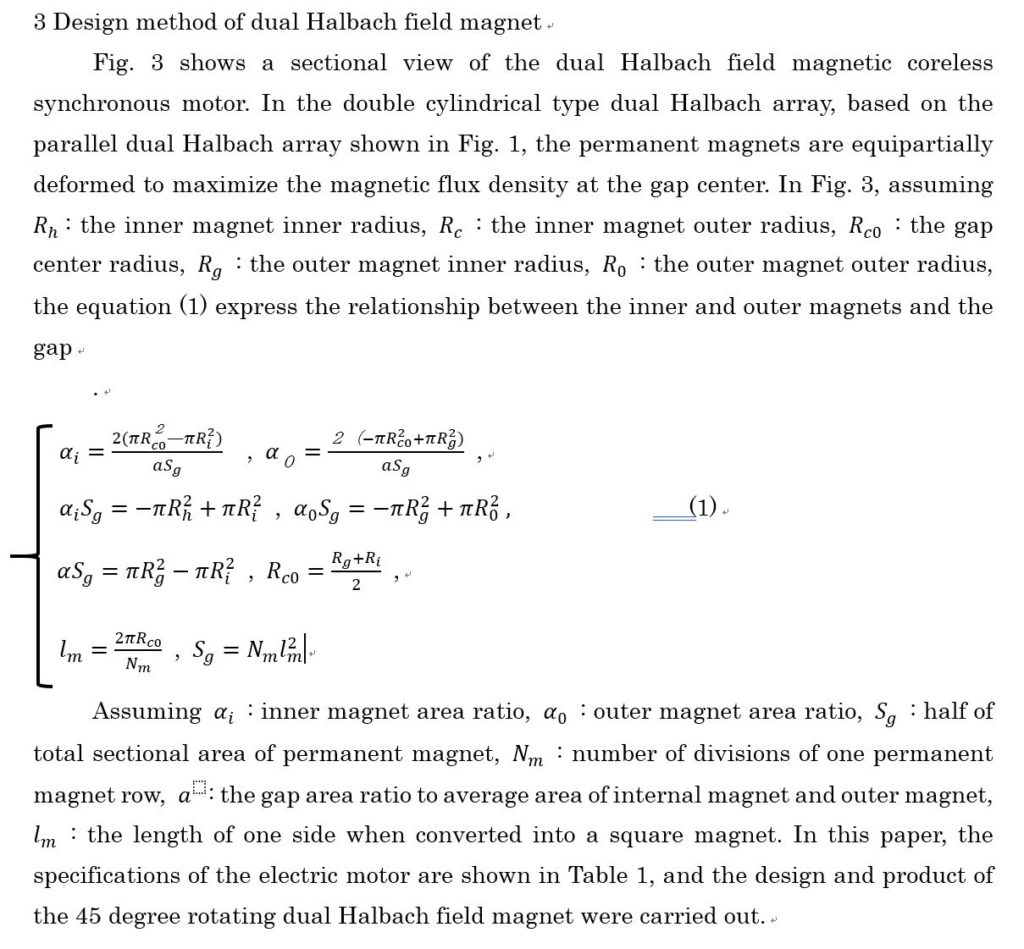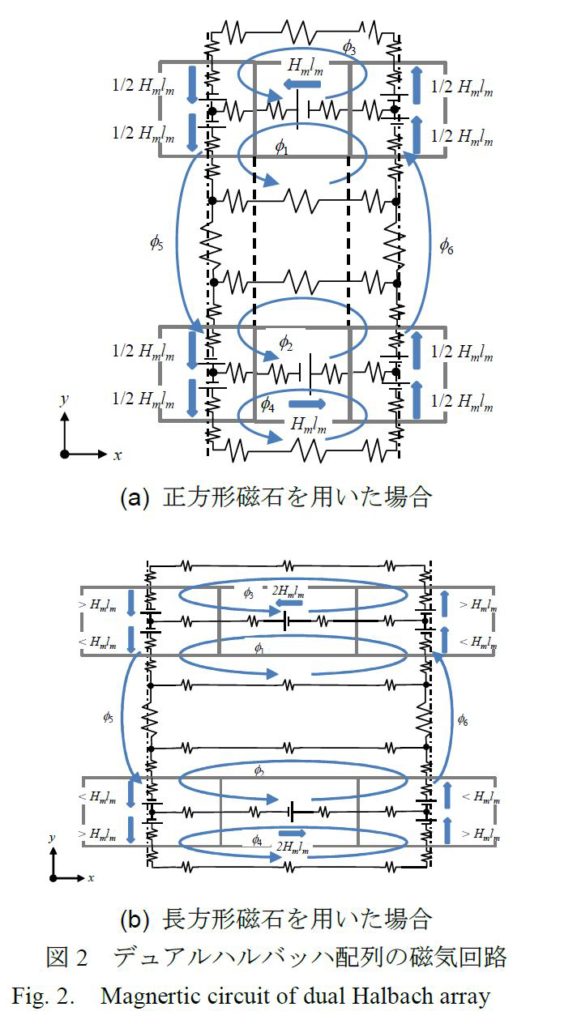The Design Method of Dual Halbach Field Magnet Coreless Synchronous Motor
Kogakuin University
An IPMSM is used for various industrial machines. However, magnetic flux density distribution in an air gap
of the IPMSM has space harmonics. Then, IPMSM causes vibration and noise problems. We focused on Halbach
array that can make the magnetic flux density distribution strong and sinusoidal, to solve such problems. This
paper describes a design method of coreless synchronous motor using dual Halbach field magnets without
harmonics of the magnetic flux density distribution.
(Keywords: Halbach array, Synchronous motor, Coreless, Design method, Space harmonics)
1, Introduction
Because the reluctance torque can utilize the interior permanent magnet synchronous motor (IPMSM), it is widely used in industry as a high performance and highly efficient electric motor. However, general IPMSM has cogging torque and torque ripple due to its structure. Cogging torque is generated by using the core. And torque ripple is caused by including a large amount of space harmonics in the magnetic flux density distribution in the gap. These cogging torques and torque ripples not only cause noise and vibration but also have a bad influence on the entire system due to the resonance phenomenon between the mechanical system and the control system. Therefore, research results have been reported attempting to make efforts from both sides of hardware and software, such as optimization of rotor shape and introduction of ripple canceller.
In our laboratory, as an approach from the hardware perspective, we focus on dual Halbach array as a magnetic field that can obtain extremely high magnetic flux density without using a core of ferromagnetic material and has less space harmonic in the gap. By utilizing the dual Halbach array, it is possible to realize a high magnetic flux density and a sinusoidal magnetic flux density distribution. So, it is possible to make coreless electric motor with extremely low cogging torque and torque ripple.
Previous studies have clarified the influence on the flux linkage number which the magnet division number and the distance between the gaps have when deforming the parallel dual Halbach field magnet to a cylindrical shape to realize a dual Halbach field magnet synchronous motor. In addition, based on these research, actual machine design using electromagnetic field analysis software was carried out.
In this paper, we report the design method of the coreless synchronous motor having the 45 ° rotary dual Halbach field which is produced according to the above design.
2 Dual Halbach array
2-1 Overview
The Halbach array is an array configured by rotating permanent magnets by predetermined angles each, a cross section along the magnetic pole direction forming a square by a predetermined angle. This array has a characteristic that a strong magnetic field appears only on one side of the permanent magnet. Dual Halbach array is composed of two rows of Halbach arrays which is arranged in a rule that sides with high magnetic flux density are opposed to each other in parallel. Fig. 1 shows the magnetic flux line distribution of the dual Halbach array. Arrows in the figure indicate magnetization directions of the permanent magnets. This array has two features. First, extremely high magnetic flux density distribution is obtained in the gap. Second, the magnetic flux density distribution at the center of the gap is sinusoidal. Furthermore, the magnetic flux leaking to the outside of the parallel magnets is small, and measures against leakage magnetic flux can be reduced. In Fig. 1, the magnetization direction of the dual Halbach array is rotated by 90 degrees each, and it is possible to create a strong sinusoidal magnetic field at the center of the gap at 45 degrees or 22.5 degrees, which is 360 degrees by multiplying by an integer.
2-2 Basic shape of permanent magnet
In the dual Halbach array, the magnetic flux concentrates on one side unless the aspect ratio of the constituent permanent magnet is extremely large. In this study, we decided to use a square permanent magnet by analyzing the dual Halbach field magnet using a magnetic circuit. Fig. 2 (a) shows a magnetic circuit with a dual Halbach array using a square magnet. In this figure, assuming that half of the permanent weak magnetomotive force magnetized in the y axis direction contributes to the main magnetic force and the other half contributes to the leakage magnetic flux, the sum of the magnetomotive forces in the closed path representing the leakage magnetic flux is zero. This means that there is no leakage magnetic flux. On the other hand, Fig. 2 (b) shows the magnetic circuit of the dual Halbach array by using the rectangular magnet. If the magnetomotive force is defined as in the case of a square magnet, the sum of the magnetomotive forces in the closed path representing the leakage magnetic flux does not become zero. In other words, when a rectangular magnet is used, there is the leakage magnetic flux.
In the case of using a dual Halbach array in a rotating machine, the shape of the permanent magnet is a fan shape. However, in this case as well, the same properties as those of a square magnet are obtained by performing equipartial deformation in the previous research.

5. At the end
In this paper, we introduce a design method ofsynchronous electric motor for blower having 45 degree rotating dual Halbach field magnet. In the future, we plan to produce actual machines based on this design method and evaluate efficiency of the motor.


